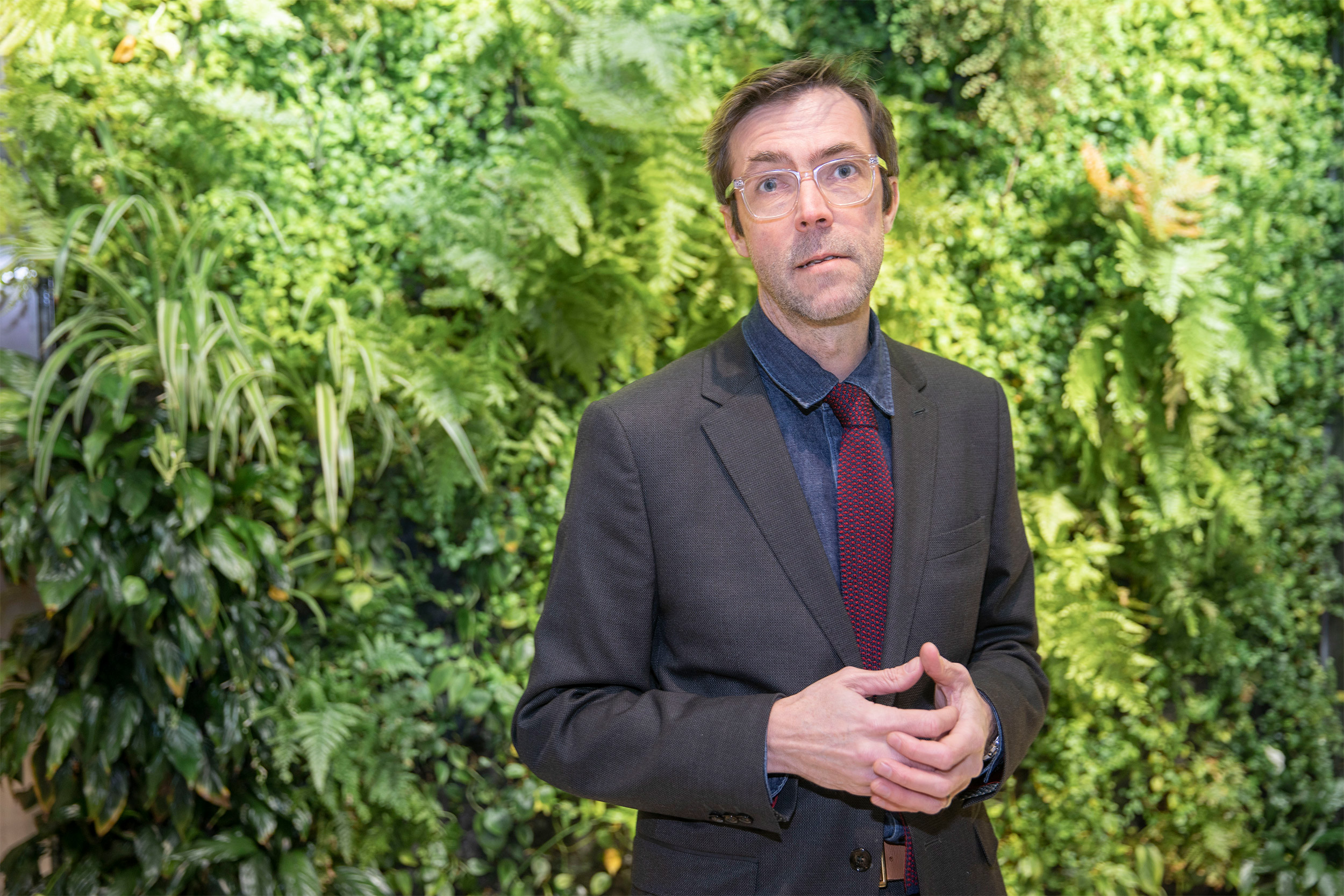
William Hanage talks about his expectations for the months ahead.
File photo by Kris Snibbe/Harvard Staff Photographer
How durable is your immunity?
William Hanage on COVID outlook for fall and winter, hybrid protection, vulnerability of older people, and the wisdom of Taylor Swift
The start of the school year brings hope, excitement, and respiratory illness. Amid reports that COVID case counts are on the rise, the Gazette spoke with William Hanage, an associate professor of epidemiology at the Harvard T.H. Chan School of Public Health and associate director for the School’s Center for Communicable Disease Dynamics, about his expectations for the months ahead. The interview has been edited for clarity and length.
Q&A
William Hanage
GAZETTE: Schools are opening and a new variant, BA.2.86, has drawn attention. What should we be watching for?
HANAGE: The “surge” you’ve been reading about is better described as an “increase.” It is very small in comparison with historical numbers. In the middle of August in Massachusetts there were a little over 100 people hospitalized primarily for COVID, according to the Department of Public Health. At the same point last year, that number was 173. So, we are talking about a genuine increase in cases, but emphatically not something that has a big impact on the healthcare system.
The important question for the fall and winter is how much protection we have from available vaccines and prior infection — our convalescent immunity. How that immunity holds up against serious illness is crucially important, but the early indications are on the positive side. That’s something we’re going to find out about in a few months, as well as how well the latest vaccines work. We can be quite sure, however, that vaccines will not work if people don’t get them.
GAZETTE: For people who got vaccinated early in the pandemic and may not have gotten a booster dose, is it likely that their immunity has waned by now?
HANAGE: They will be very unlikely to have any immunity to infection, but they will likely have immunity against severe illness. Unfortunately, though, the group for which that’s least likely to be the case is older people. In that group, immunosenescence starts to take over, alongside other comorbidities. That is the group about which we are most concerned.
A large proportion of us have hybrid immunity by now. We have been vaccinated, infected, and now have two forms of immunity. We have reason to think that hybrid immunity is more durable, based on studies of antibody titers. How protective it actually is will depend on things like which virus you get confronted with.
“For context, COVID has killed more than 100,000 Americans this year already. That is twice what would be considered a ‘bad’ flu year.”
GAZETTE: How has the new variant changed the outlook?
HANAGE: A couple weeks ago I’d have expected to be talking about the EG.5 variant, which has been growing in case counts in the United States. But a few weeks ago, everybody in the business found their feeds lighting up as BA.2.86 flashed across our radar. The reason people are worried about it is that it has a lot of change, especially in the spike gene, which is what vaccines target. That has not really been seen since the original emergence of Omicron. Upon seeing that and seeing that these mutations are overwhelmingly among sites which have been found to be important for immunity, everybody’s spider sense started jangling.
GAZETTE: Has the variant been seen in the U.S.?
HANAGE: There are multiple introductions to the U.S. The reason it attracted attention was because the first sequence came from Denmark, shortly followed by a report from Israel. So not only did this look alarming, it was also good enough at spreading to have managed to get to both Denmark and Israel. We have slacked off monitoring and surveillance so much that we were anxious that it could be flying under the radar in many other places.
GAZETTE: If you detect a case or two in those two countries, there are many more cases that are undetected — is that the fear?
HANAGE: If you don’t look, you don’t find. But since then, BA.2.86 has a lot of people scratching their heads. It’s turned up in the U.K. and in the U.S. it’s been in Michigan and Virginia. There’s evidence from wastewater in Ohio, and it just showed up in Texas. It was found in the traveler screening program as well, so we know that it’s widespread. Yet it doesn’t seem to be growing quickly in any of these places. Folks have been waiting eagerly to see subsequent reporting from the places that still have pretty good surveillance, like Denmark. But since that first infection, cases have only trickled in from Denmark. That is consistent with it beginning to spread, but it is not doing so explosively.
So we can rule out anything remotely like BA.1 or BA.2, because if it was like that, we would have heard about it by now. It looks like it had an origin in the last few months, but we don’t know why cases are so geographically widespread. Some people think there could have been a superspreading event at a large gathering where people from many countries came, were infected, and carried it back with them, and that’s where my money is. Right now, the important thing is that it’s not growing wildly, so we can exclude the really bad stuff. We need to monitor it, because the consequences could still be important, even if I don’t think it’s going to bring us anywhere close to where we’ve been in the past.
GAZETTE: Have vaccines been updated to account for the latest variants?
HANAGE: They have been tuned to XBB.1.5, against the expectation that we would see something like EG.5. Just like with flu vaccines, we have to make a call as to what variant we expect to be significant. Unlike flu vaccines, COVID throws us more curveballs and we’ve seen pretty large jumps between variants in the past, but the protection against severe illness over the longer time period has seemed to hold up really quite well. That’s been the case with repeated divergent variants, so I don’t see a reason to think that this is going to be very different.
GAZETTE: I was going through recent CDC data and noticed that COVID deaths nationally hit a pandemic low in the middle of August.
HANAGE: That’s one of the reasons why, rather than talking about a “surge,” it’s important to note when things are good, and what we can do to make them better.
GAZETTE: And things are pretty good right now?
HANAGE: Things are, relatively speaking, pretty good. But we do have a reasonable caution around respiratory virus syndrome season in general. For context, COVID has killed more than 100,000 Americans this year already. That is twice what would be considered a “bad” flu year. So, thinking about the infectious diseases from which we tolerate more than 10,000 deaths, the answer was really only flu, up until COVID.
Flu would cause between 20,000 and 50,000 deaths — 60,000 in a bad year. Last year was a bad flu year, incidentally. Now we’ve got something on top of that, a burden that our healthcare system has to shoulder, and it will have knock-on consequences.
GAZETTE: Are there other trends that are important as we look to the fall and winter?
HANAGE: The most important things are vaccines — talk to your healthcare provider about it. Making them something you have to pay for is not a good idea. The same is true for access to paxlovid and other effective therapeutics. They are remarkably underused. Also — this is common sense — if you have a horrible head cold, hold off going to see grandma. And if you think you might have COVID, be conscientious. Wait a few days and do a rapid test. A mask will help. A lot of people say, “We’ve moved past this, don’t wear a mask,” but somebody could be wearing a mask for all sorts of reasons. They might be wanting to go see their grandma. They might be hoping to take a long-awaited vacation and are keen to not get COVID. They might be anxious about their own health. Human beings can reasonably have different feelings about this right now. My daughter’s really into Taylor Swift, who recently advised her fans to “be kind.” Being kind is something we should all get behind.








